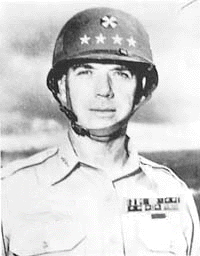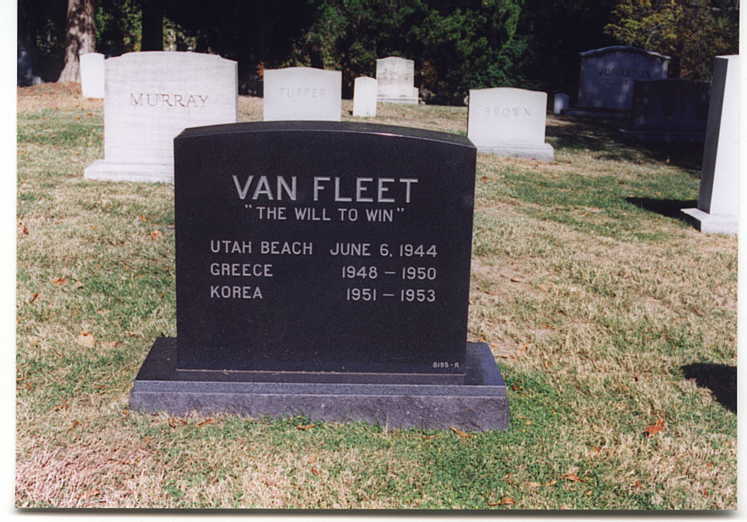
|



|
Born: 19 Mar 1892 Died: 23 Sep 1992
Then Colonel James A. Van Fleet commanded the 8th Infantry Regiment from July 1941 to
July 1944. Members of the 29th Field Artillery accompanied him as he led the 8th ashore
at UTAH BEACH, during the June 6, 1944 Invasion of Normandy. He was assistant division
commander of the 2nd Infantry Division during September-October 1944 during the the battle
for, and liberation of Brest. He commanded the 90th Infantry Division from October, 1944
until March 17, 1945. He then commanded III Corps through VE Day, until his proposed redeployment
to the Pacific Theater. After serving in World War II, he was promoted to Lieutenant General and headed
the US military mission that aided the Greek army in its successful campaign against Communist
guerillas from 1948 to 1950. He was the Field Commander of United Nations Forces in Korea from
1951 to 1953. He retired from active duty in 1953 with the rank of General. After his retirement,
he served as a consultant to the Secretary of the Army on guerilla warfare from 1961 to 1962,
and was an executive and director of several business firms.
The Punchbowl Battles, specifically Bloody and Heartbreak Ridges.
Units: 2nd U.S. Inf Division, ROK I
Corps, 1st U.S. Marine Division, and the French Battalion. Late in
August 1951, after the truce negotiations
had been suspended, Van Fleet, determined to resume the offensive in
order to drive the enemy farther back
from the Hwachon Reservoir (Seoul's source of water and electric power)
and away from the Chorwon-Seoul
railroad. Success in each of these enterprises would also straighten and
shorten the U.N. front, give greater
security to the KANSAS Line, and inflict damage on the enemy. Therefore,
the U.N. commanders decided to put
forth a major effort in the X Corps zone, using all five divisions in
that corps to continue the ridge-top and
mountain actions in the Punchbowl area. The U.S. 1st Marine Division,
with ROK marine units attached, opened
a drive against the northern portion of the Punchbowl August 31. Two
days later the 2nd Division attacked
northward against Bloody and Heartbreak Ridges in the vicinity of the
Punchbowl's western edge and Taeu-san.
Both assaults, delivered uphill by burdened, straining infantrymen, met
with initial success. By September 3,
the two divisions had reached their first objectives. General Van Fleet ordered
them to continue the advance as far north
as the northwesterly leg of the Soyang River above the Punchbowl. The
1st Marine Division attacked again
September 11. After seven days of heavy fighting, with the enemy
resolutely defending each ridge top from
mutually supporting positions and yielding only after repeated
counterattacks and seesaw struggles, the
Marines secured their objectives September18. Meanwhile, the 2nd
Division, on Bloody and Heartbreak Ridges
west of the Punchbowl, was engaged in the fiercest action since spring.
Like the Marines, the 2nd Division
infantrymen, often carrying 60-mm mortar or 75-mm recoilless rifle
rounds as well as their own ammunition
and equipment, crawled hand-over-hand up towering, knife-crested ridges
to assault the hard-fighting enemy
who would yield a ridge only in desperation, then strike back in
vigorous counterattack. The same crest often
changed hands several times each day. By September 19, the X Corps front
was stabilized except in the 2nd
Division's zone. Supplied by airdrop and by sturdy Korean carriers with
A-frames strapped to their backs, and
heavily supported by aircraft and artillery, the 2nd Division fought
bitterly. In one instance it delivered, within
the space of 24 hours, no less than 11 separate assaults, all
unsuccessful, against one ridge. The battle raged
into October. Finally, on the 14th, after the enemy seemed to be willing
to reopen the truce talks, the last ridge
was secured and the 2nd Division consolidated its hard-won gains.
"I am ashore with Colonel Simmons and General Roosevelt, advancing
steadily (0940). ... Everything is going OK (1025).... Defense is not
stubborn (2400)." Thus did Col. James A. Van Fleet report the progress
of his 8th Infantry to his commanding officer, Maj. Gen. Raymond O.
Barton of the 4th Division, on D Day, 6 June 1944. These messages were
confirmed by liaison officers returning to the headquarters ship, U.S.S.
Bayfield, after trips to the beach: "Everything is moving along very
nicely." To Maj. Gen. J. Lawton Collins, commanding the VII Corps, these
reports were reassuring indications that at least a foothold had been
secured on the Cotentin Peninsula and with less difficulty than had been
feared. Quotation from "From Utah Beach to Cherbourg"
Gloucester (Gloster) Hill. Units: 1st Battalion, Gloster Regiment,
29th British Brigade. After withdrawal
from North Korea, U.N.C. ground forces launched a series of successful
advances toward Line Kansas just
north of the 38th parallel. These were Operations Thunderbolt, Killer
and Rugged. The enemy struck back in
strength on April 22, 1951, attempting a double envelopment of I and IV
Corps. Withdrawal of friendly units on
I Corps' left flank isolated the Gloster Battalion. Repeated efforts by
I Corps to relieve the unit were
unsuccessful and the battalion, cut off and overrun, fought until its
ammunition was gone. The Glosters' stand
cost them 1,100 casualties; only four officers and 36 enlisted men made
it back to U.N.C. lines. GEN James A.
Van Fleet, then Eighth Army commander, called it "the most outstanding
example of unit bravery in modern
warfare."


His Comrades Mourn His Loss !
